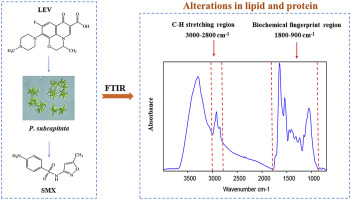当前位置:
X-MOL 学术
›
Chemosphere
›
论文详情
Our official English website, www.x-mol.net, welcomes your feedback! (Note: you will need to create a separate account there.)
Levofloxacin and sulfamethoxazole induced alterations of biomolecules in Pseudokirchneriella subcapitata.
Chemosphere ( IF 8.8 ) Pub Date : 2020-04-08 , DOI: 10.1016/j.chemosphere.2020.126722 Qian Xiong 1 , You-Sheng Liu 2 , Li-Xin Hu 2 , Zhou-Qi Shi 1 , Guang-Guo Ying 2
Chemosphere ( IF 8.8 ) Pub Date : 2020-04-08 , DOI: 10.1016/j.chemosphere.2020.126722 Qian Xiong 1 , You-Sheng Liu 2 , Li-Xin Hu 2 , Zhou-Qi Shi 1 , Guang-Guo Ying 2
Affiliation

|
Levofloxacin (LEV) and sulfamethoxazole (SMX) are two extensively used antibiotics. Most investigations have been concentrated on the toxic effects of antibiotics on algal species evaluated with traditional ecotoxicological endpoints; however, limited information is available on the alterations in biomolecules induced by antibiotics. Here we investigated alterations in the structure and function of biomolecules to a model species Pseudokirchneriella subcapitata following exposure of LEV and SMX by applying Fourier transform infrared spectroscopy (FTIR). The growth inhibition tests revealed that both LEV and SMX had negative effects on algal growth, while SMX was found to be more toxic to P. subcapitata than LEV. Based on the FTIR analysis, alterations in the structure, composition and function of lipids and proteins were observed on microalgal cells, which were correlated with the dosage of LEV and SMX. As a result of lipid peroxidation induced by LEV and SMX, an increase in the lipid/protein ratio and decrease in the ratios of CH2/lipid, CH3/lipid, carbonyl ester/lipid and olefinic = CH/lipid were observed in all treatment groups with respect to the reference control. Moreover, alterations in the composition and secondary structure of proteins were also observed in accompany with a decrease in the Amide I/Amide II ratio and an increase of the loose β-sheet structure protein. LEV caused an elevated level of lipid peroxidation, while SMX induced a more obvious protein aggregation. The findings from this study showed that FTIR could reveal the toxic mechanism of these two antibiotics to algae at the biochemical level by linking alterations in biomolecules to biochemical dynamics and function.
中文翻译:

左氧氟沙星和磺胺甲恶唑诱导人头假单胞菌生物分子的改变。
左氧氟沙星(LEV)和磺胺甲恶唑(SMX)是两种广泛使用的抗生素。大多数研究集中在用传统生态毒理学终点评估抗生素对藻类的毒性作用上。然而,关于由抗生素诱导的生物分子的改变的信息很少。在这里,我们通过应用傅立叶变换红外光谱法(FTIR)研究了LEV和SMX暴露后对模型物种假单胞假单胞菌生物分子的结构和功能的改变。生长抑制测试表明,LEV和SMX均对藻类生长产生负面影响,而SMX被发现对人次疟原虫的毒性大于LEV。根据FTIR分析,结构发生变化,在微藻细胞上观察到脂质和蛋白质的组成和功能,这与LEV和SMX的剂量有关。由LEV和SMX诱导的脂质过氧化作用的结果是,在所有治疗组中均观察到脂质/蛋白质比增加,CH2 /脂质,CH3 /脂质,羰基酯/脂质和烯烃= CH /脂质的比率降低关于参考控件。此外,还观察到蛋白质组成和二级结构的改变,同时伴随着酰胺I /酰胺II比例的降低和疏松的β-折叠结构蛋白的增加。LEV引起脂质过氧化水平升高,而SMX引起更明显的蛋白质聚集。
更新日期:2020-04-08
中文翻译:

左氧氟沙星和磺胺甲恶唑诱导人头假单胞菌生物分子的改变。
左氧氟沙星(LEV)和磺胺甲恶唑(SMX)是两种广泛使用的抗生素。大多数研究集中在用传统生态毒理学终点评估抗生素对藻类的毒性作用上。然而,关于由抗生素诱导的生物分子的改变的信息很少。在这里,我们通过应用傅立叶变换红外光谱法(FTIR)研究了LEV和SMX暴露后对模型物种假单胞假单胞菌生物分子的结构和功能的改变。生长抑制测试表明,LEV和SMX均对藻类生长产生负面影响,而SMX被发现对人次疟原虫的毒性大于LEV。根据FTIR分析,结构发生变化,在微藻细胞上观察到脂质和蛋白质的组成和功能,这与LEV和SMX的剂量有关。由LEV和SMX诱导的脂质过氧化作用的结果是,在所有治疗组中均观察到脂质/蛋白质比增加,CH2 /脂质,CH3 /脂质,羰基酯/脂质和烯烃= CH /脂质的比率降低关于参考控件。此外,还观察到蛋白质组成和二级结构的改变,同时伴随着酰胺I /酰胺II比例的降低和疏松的β-折叠结构蛋白的增加。LEV引起脂质过氧化水平升高,而SMX引起更明显的蛋白质聚集。


























 京公网安备 11010802027423号
京公网安备 11010802027423号